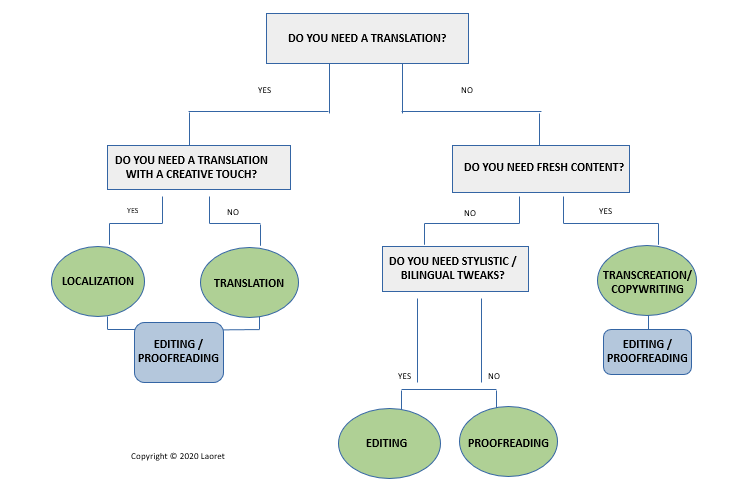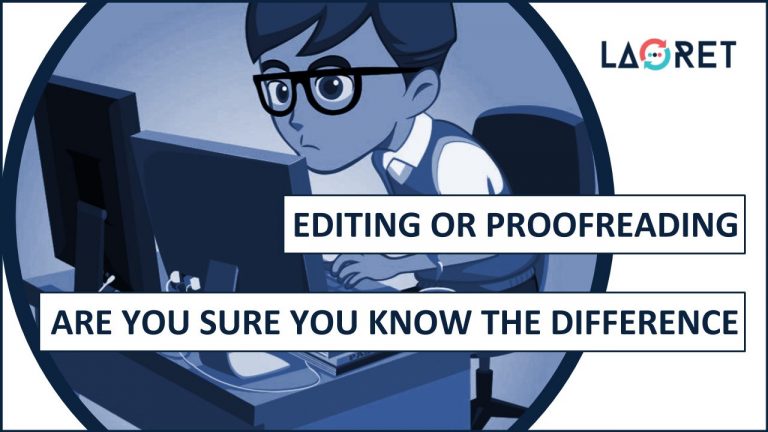Editing Or Proofreading: Are You Sure You Know The Difference?
What’s this? Another blog about the difference between Editing and Proofreading? Well, we certainly don’t want to expand on topics that have already been discussed many times. What we do want, however, is to offer practical insights based on the most common client needs.
For example, we see it happens quite often that a client requests a Proofreading Service, while a quick orientation meeting revealed they were actually looking for Editing or Revision Service.
So, in order to clear the air once and for all, let us present you with the definitive guide of what these Services entail, and, more importantly, when they will benefit you most.

Editing: Combing Bilingual Review With Brand Identity
“(the) bilingual examination of target language content against source language content for its suitability for the agreed purpose.â€
Official ISO-Definition of Editing 2
| THE EDITOR IS A PROFESSIONAL WHO: | THE EDITING PROCESS FOCUSES STRONGLY ON: |
| – Is also a highly trained translator native in the target language and lives in the target locale. – Confirms that spelling, grammar, and punctuation are correct. – Possesses deep subject knowledge |
– The use of the Style Guide and Glossary (created for the translation phase) as a reference for brand accuracy and effective terminology management. – Reviewing the translation with an eye in the source text and a sense of the cultural application of the content. |

Editing is the stage of quality checks right after the translation itself, which is why this service has one foot still in the translation process, and another firmly positioned within the review phase. Stylistic and bilingual aspects are reviewed extensively while the target language is also checked for grammatical consistency and spelling. Since Editors are located in the target locale, they can also cast a keen eye on the translation’s cultural potency.
Note: Editing or Post-Editing?
You may have seen the term “Post-Editing†pop up more and more and wondered if this is something that could benefit you. Post-Editing is rapidly gaining traction due to the consistent rise of Machine Translation. While traditional editing is a critical part of any process involving Human Translation, Post-Editors are skilled in handling content specifically obtained through Machine Translations and are trained in maximizing the speed and efficiency Machine Translation is known to boost.
Pro Tip! Learn More About Post-Editing And How It Is Best Executed Here
Proofreading: Confirming The Linguistic Integrity Of The Target Language
“(to) examine the revised target language content and apply corrections before printing.â€
Official ISO-Definition of Proofreading
In other words, Proofreading is about checking the edited translation and make sure it is free of any spelling or grammatical mistakes, confirm that each sentence’s structure is correct, and ensure the use of language is geared towards the target audience.
| THE PROOFREADER IS A PROFESSIONAL WHO: | INCLUDE THE ORIGINAL TRANSLATOR TO CHECK FOR: |
| – Doesn’t necessarily have comprehensive knowledge of the source language, but is native and highly trained in the target language – Possesses in-depth knowledge of the subject matter – Double-checks that the spelling, grammar, and punctuation are consistent and correct |
– Linguistic Quality: Does the translation fit the content strategy goals and has it been incorporated correctly into the file? – Cosmetic Quality: Is all the content correctly integrated and are the images localized correctly? – Functionality: Has the appropriate font and font-size been selected to create the perfect reading experience? |
Where the Editing Phase still incorporates bilingual review and pays attention to some of the stylistic requirements set up by the client, the proofreader only checks for the linguistic qualities of the target language itself. Since the Proofreader may not even possess full command of the source language and has no reference to the original text, they can approach the content with a fresh look, uncomplicated by considerations other than the content before them.

Which Other Services Do You Require?
When checking the flowchart, we’d like to invite you to consider which type of translation or content creation strategy you need. As you may have guessed from the outline of the differences between Editing and Proofreading, it is important to understand what services are out there and how they could benefit your brand.
- Standard Translations work best with straightforward or highly technical content.
- Transcreation is fit for those projects where translations need to go hand in hand with a marketing strategy to mold the content for various target locales.
- Copywriting involves the creation of fresh content in the target language, that focuses on native brand experience.
Also, note that each one of these should be followed by Editing and Proofreading in order to guarantee the highest possible quality.
Conclusion:
Editing and Proofreading are two very different services that complement each other perfectly within a well-balanced TEP-Process. While available as an independent service, we encourage you to seek out expertise every step of the way to make sure your road to global success is made easier with the help of the perfectly polished product.
At Laoret, our ISO 9001 and ISO 17100 Certified Translation Solutions, ensure top quality control from the selection of highly trained translators to professional editing and proofreading services. We have created a streamlined process from the ordering to the final delivery so that top quality is seamlessly combined with efficiency and cost-effectiveness.






